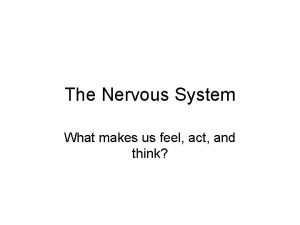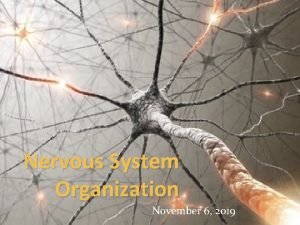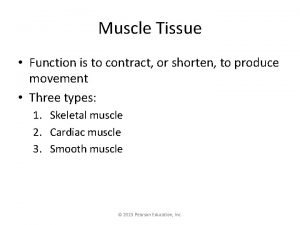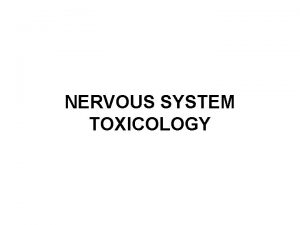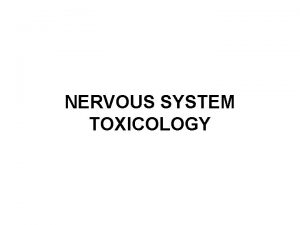Doha Rottluff Nervous System Nervous System Function The

















- Slides: 17

Doha Rottluff Nervous System

Nervous System Function The human nervous system controls everything from breathing and producing digestive enzymes, to memory and intelligence. http: //www. investinlibya. org/knowing-about-humanbrain-nerve/brain-and-nerve-nervous-system/ https: //en. wikipedia. org/wiki/Spinal_cord

The Central Nervous System is the part of the nervous system that consists of the brain and spinal cord. (brain and spinal chord) (1) Peripheral nervous system- The portion of the nervous system that is outside the brain and spinal cord. (12 cranial nerves, the spinal nerves and roots, and autonomic nerves, the muscles in blood vessel walls, and glands. ) (1)

Interaction of two neurons

Reflex Arc In a simple reflex arc, such as the knee jerk, a stimulus is detected by a receptor cell, which synapses with a sensory neurone. The sensory neurone carries the impulse from site of the stimulus to the central nervous system (the brain or spinal cord), where it synapses with an interneurone. The interneurone synapses with a motor neurone, which carries the nerve impulse out to an effector, such as a muscle, which responds by contracting. (2)

Cerebral hemispheres The left hemisphere is dominant with regard to language and logical processing, while the right hemisphere handles spatial perception The brain is separated into the frontal, temporal, occipital, and parietal lobes. The frontal lobe is associated with executive functions and motor performance. The temporal lobe is associated with the retention of short- and long-term memories. It processes sensory input, including auditory information, language comprehension, and naming. The occipital lobe is the visual-processing center of the brain. The parietal lobe is associated with sensory skills. (3)

Diencephalon is made up of four distinct components: the thalamus, the subthalamus, the hypothalamus, and the epitheliums. The hypothalamus is an integral part of the endocrine system, with one of the most important functions being to link the nervous system to the endocrine system via the pituatary gland. The thalamus is critically involved in a number of functions including relaying sensory and motor signals to the cerebral complex, and regulating consciousness, sleep, and alertness. The epithalamiums functions as a connection between the limbic system to other parts of the brain. Some functions of its components include the secretion of melatonin by the pineal gland (involved in circadian rhythms) and regulation of motor pathways and emotions. (3)

Medulla “Brain System” The medulla oblongata is a portion of the hindbrain that controls autonomic functions such as breathing, digestion, heart and blood vessel function, swallowing and sneezing. Motor and sensory neurons from the midbrain and forebrain travel through the medulla. As a part of the brainstem, the medulla oblongata helps in the transferring of messages between various parts of the brain and the spinal cord. (4)

Cerebellum The cerebellum receives information from the sensory systems, the spinal cord, and other parts of the brain and then regulates motor movements. The cerebellum coordinates voluntary movements such as posture, balance, coordination, and speech, resulting in smooth and balanced muscular activity. It is also important for learning motor behaviors. (5)

Nerve Impulse Neurons send messages electrochemically; this means that chemicals (ions) cause an electrical impulse. Stages Resting potential is when a neurone is not sending a signal. The resting potential tells us about what happens when a neurone is at rest. Action potential occurs when a neurone sends information down an axon. This involves an explosion of electrical activity, where the nerve and muscle cells resting membrane potential changes. (5)

At rest, the inside of the neuron is slightly negative due to a higher concentration of positively charged sodium ions outside the neuron. When stimulated past threshold (about – 30 m. V in humans), sodium channels open and sodium rushes into the axon, causing a region of positive charge within the axon. This is called depolarisation The region of positive charge causes nearby voltage gated sodium channels to close. Just after the sodium channels close, the potassium channels open wide, and potassium exits the axon, so the charge across the membrane is brought back to its resting potential. This is called repolarisation. This process continues as a chain-reaction along the axon. The influx of sodium depolarises the axon, and the outflow of potassium repolarises the axon. The sodium/potassium pump restores the resting concentrations of sodium and potassium ions http: //www. biologymad. com/Nervous. Syste m/nerveimpulses. htm

Neurotransmitters NEUROTRANSMITTERS are the brain chemicals that communicate information throughout our brain and body. They relay signals between nerve cells, called “neurons. ” The brain uses neurotransmitters to tell your heart to beat, your lungs to breathe, and your stomach to digest. They can also affect mood, sleep, concentration, weight, and can cause adverse symptoms when they are out of balance. (6) At the synaptic terminal (the presynaptic ending), an electrical impulse will trigger the migration of vesicles containing neurotransmitters toward the presynaptic membrane. The vesicle membrane will fuse with the presynaptic membrane releasing the neurotransmitters into the synaptic cleft.

Neurotransmitters Diagram http: //www. quia. com/files/quia/users/granitestatecollege/drugeducation /Lesson 2. htm http: //spring 09. socworld. com/Unit_2/Page_1. html

EPSP and IPSP • EPSPs are graded potentials that can initiate an AP in the axon • IPSPs produce a graded potential that lessens the chance of an AP in an axon. • EPSP - small depolarization is created • IPSP - small hyperpolarization is created. • EPSP - helps bring postsynaptic membrane closer to threshold • IPSP - helps bring postsynaptic membrane further from threshold. EPSP - membrane becomes more excited • IPSP - membrane becomes less excited

Stroke A stroke occurs when the blood supply to part of your brain is interrupted or severely reduced, depriving brain tissue of oxygen and nutrients. Within minutes, brain cells begin to die. Symptoms: trouble walking, talking, understanding or seeing/ headache Strokes kills almost 130, 000 Americans each year—that’s 1 out of every 20 deaths Treatment: To treat an ischemic stroke, doctors must quickly restore blood flow to your brain. Aspirin is an immediate treatment for a stroke. Also an injection of TPA.

Dysautonomia Dysautonomia refers to a disorder of autonomic nervous system (ANS) function that generally involves failure of the sympathetic or parasympathetic components of the ANS, but dysautonomia involving excessive or overactive ANS actions also can occur. The symptoms of dysautonomia conditions are usually “invisible” to the untrained eye. To the casual observer, the dysautonomia patient can appear to be healthy. The manifestations of the conditions are occurring internally, and although the symptoms are quantifiable and verifiable medically they are not visible on the outside (people cannot see fast heart rates, blood pressure changes, dizziness, migraines, stomach pain etc. ) There is no cure for Dysautonomia. https: //www. google. com/search? q=dysautonomia+statistics&rlz=1 C 1 CHFX_en. US 611 US 656&es pv=2&biw=1097&bih=559&site=webhp&source=lnms&tbm=isch&sa=X&sqi=2&pjf=1&ved=0 CAc Q_AUo. Amo. VCh. MI 0 OS 5 t. ZLGy. AIVQUlj. Ch 1 y. WAHp&dpr=1. 75#imgdii=v. ONxb. Gkc. L 5 e. KBM%3 A%3 Bv. ONxb. Gkc. L 5 e. KBM%3 A%3 B 2 vc 6 kseiyu. Xs. IM%3 A&imgrc=v. ONxb. Gkc. L 5 e. KBM%3 A

Reference Page (1)- http: //www. medicinenet. com/script/main/art. asp? articlekey=8258 (2)http: //www. biologymad. com/master. html? http: //www. biologymad. com/Nervo us. System/Nervous. System. htm (3) Source: Boundless. “Cerebral Hemispheres and Lobes of the Brain. ” Boundless Psychology. Boundless, 20 Aug. 2015. Retrieved 16 Oct. 2015 from https: //www. boundless. com/psychology/textbooks/boundless-psychology-textbook/biologicalfoundations-of-psychology-3/structure-and-function-of-the-brain-35/cerebral-hemispheres-and-lobesof-the-brain-153 -12688/ (4) http: //biology. about. com/od/anatomy/p/medulla-oblongata. htm (5) http: //www. healthline. com/human-body-maps/cerebellum (6)https: //www. neurogistics. com/The. Science/Whatare. Neurotransmi 0 9 CE. asp (7) http: //www. dynainc. org/dysautonomia/symptoms
 Which neuron is rare
Which neuron is rare Fundamentals of the nervous system and nervous tissue
Fundamentals of the nervous system and nervous tissue Processes neuron
Processes neuron Ashta prakari puja doha in hindi
Ashta prakari puja doha in hindi Doha expo 2021 project
Doha expo 2021 project Doha port stadium
Doha port stadium Aquaculture doha
Aquaculture doha Nervous system function
Nervous system function Nervous system function
Nervous system function Nervous system and digestive system
Nervous system and digestive system Endocrine system vs nervous system
Endocrine system vs nervous system Mechanism of action of hormones
Mechanism of action of hormones Endocrine system and nervous system
Endocrine system and nervous system Supporting cells
Supporting cells Hát kết hợp bộ gõ cơ thể
Hát kết hợp bộ gõ cơ thể Ng-html
Ng-html Bổ thể
Bổ thể Tỉ lệ cơ thể trẻ em
Tỉ lệ cơ thể trẻ em







